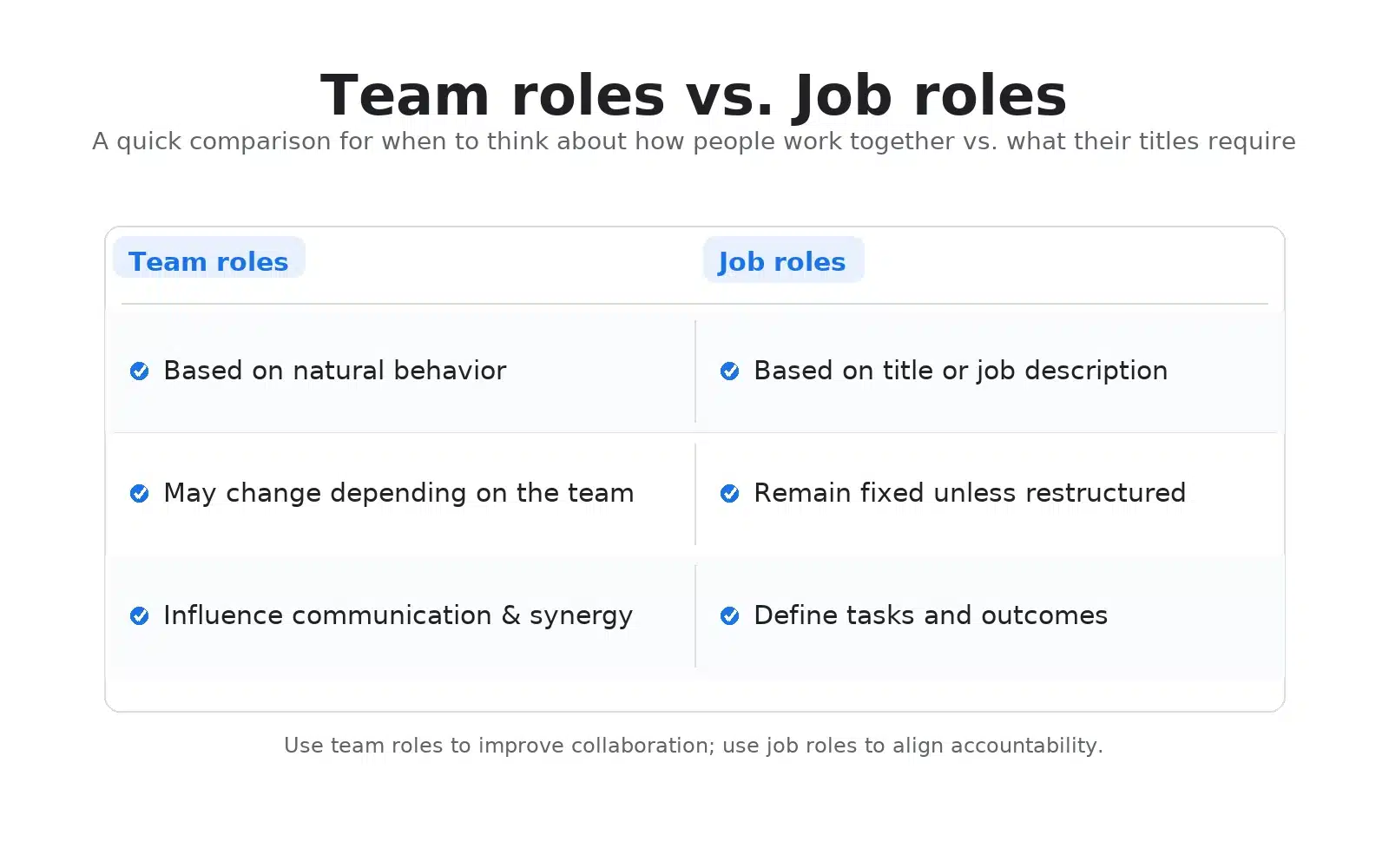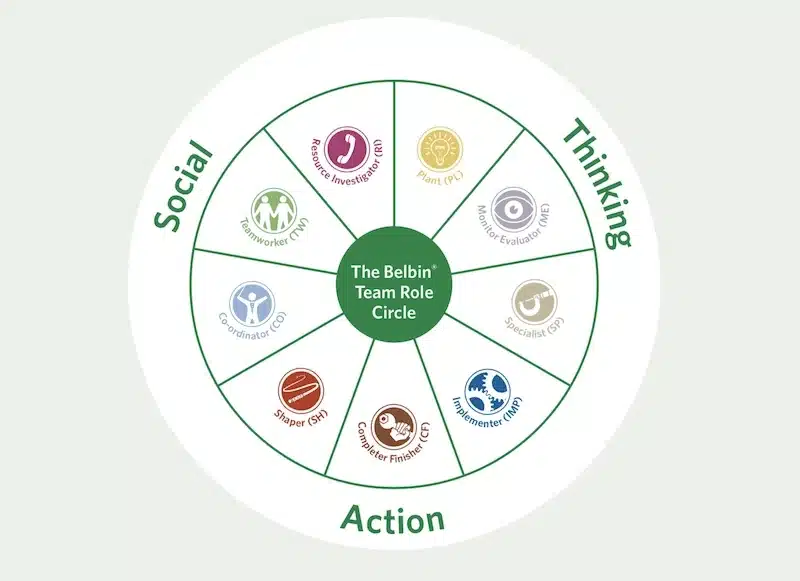
Discover how understanding team roles can boost collaboration, improve communication, and strengthen team dynamics. Learn how to apply team roles in real corporate settings.
Imagine you and several friends are taking a weekend trip. One of you shows up with a list of restaurants and clubs within walking distance of where you’re staying, another volunteers to organize cabs and ride shares, while a third person settles any disagreements.
Researcher, organizer, and peacemaker would be their respective team roles. And because those roles complement each other and fill specific needs, they enable the group to enjoy the getaway much more: no standing around in the rain, arguing about what to do next or how to get there!
In this blog post, we discuss the effects of team roles in the workplace, how team roles differ from job roles, and the dos and don’ts of balancing roles within a team for optimal team dynamics.
What are Team Roles?
Team roles define how people behave within a group. Whereas job titles and descriptions outline responsibilities, team roles describe someone’s big-picture function within the group. Do they come up with new ideas or finesse the details? Do they typically plunge into action or wait for consensus? Are they subject to unpredictable bursts of energy or progress in a slow, steady, reliable manner?
It makes sense that teams perform best when there’s a healthy balance of team roles. Creators need implementers to bring their ideas to life, for instance. A well-balanced team communicates more effectively and resolves conflicts more efficiently than a lopsided one. Fewer tasks and details fall through the cracks, and duplication of efforts is minimized. And all this, in turn, enables the team to efficiently and effectively achieve its goals.
Belbin's Definition of Team Roles
Beginning in the 1960s, Dr. Meredith Belbin meticulously studied group and team behavior, eventually forming his theory of behavioral team roles. He found that high-performing groups consisted of teammates who exhibited nine complementary types of behaviors.
That doesn’t mean teams need at least nine members to succeed; typically, an individual will perform multiple roles based on the circumstances, but most teams need their collective members to assume all nine behaviors between them to be successful.
The Belbin team roles model consists of three broad categories of roles, each with three distinct roles:
Thought-Oriented Team Roles
- Creative and innovative, the Plant role generates ideas and solves problems by thinking outside of the proverbial box. Follow-through and details aren’t their strong suits, however.
- The Monitor Evaluator examines ideas through a logical, rational lens. While this analytical ability enables them to detect flaws in potential solutions, it also prevents them from making quick decisions and sometimes leads them to dampen others’ enthusiasm.
- The Specialist is just that: someone with in-depth knowledge of a particular area. If a project falls within their forte, you definitely want to include them; just be sure they don’t get lost in the minutiae.
Action-Oriented Team Roles
- The tenacious Shaper role is determined to push the team toward success. They thrive under pressure and have seemingly endless energy, but not much empathy for anyone they perceive as an obstacle.
- The Implementer turns concepts into plans and ideas into actions. Efficient, organized, and reliable, they can also be somewhat inflexible if presented with alternatives to a proposal they’d perceived as good to go.
- The detail-oriented Completer Finisher will do everything in their power to ensure that the final product is as close to flawless as possible. Being a perfectionist, though, they’re reluctant to delegate.
People-Oriented Team Roles
- The Resource Investigator is an excellent curator of external ideas, talent, and support. Strong on networking and initial enthusiasm, they often run out of interest and energy before a project’s completion.
- If anyone in the group is going to declare “Teamwork makes the dream work,” it’s the Teamworker. They listen, they’re diplomatic, and they’re key in resolving conflicts. They also foster team collaboration and trust. That said, they’re also reluctant to take sides or make major decisions.
- The Coordinator role excels at clarifying objectives and delegating team responsibilities in the workplace. They’re so good at delegating, in fact, that they might leave themselves little to do.
Looking at these different types of team roles, you can see how one member might assume several throughout a project.
The Plant role, who kicks things off with a creative concept, might become a Shaper — an encourager — once the work gets underway. An Implementer, who turns ideas into action, might also be a Teamworker or a Completer Finisher, or both.
You can see the importance of filling most, if not all, the team roles. A team without someone in the Shaper role might miss deadlines due to flagging interest, for instance. On the other hand, it’s possible to have too much of a good thing. A team consisting exclusively of Teamworkers could be so averse to conflict that they might fail to express dissenting opinions, no matter how valid and vital.
The Difference Between Team Roles and Job Roles
The behaviors that define team roles sometimes overlap with job roles. The perfectionism that makes for a great proofreader is typical of a Completer Finisher, for instance. But job roles describe the tasks an individual is expected to perform and the outcomes they are supposed to achieve. Based on natural behaviors, team roles describe how individuals influence communication and cohesiveness within the group dynamic.

What’s more, job roles are relatively static. The proofreader’s job is more or less the same regardless of the type of content they’re reviewing and the team for whom they’re reviewing it. Team roles, however, often change depending on who else is in the group and the state of a project. If a team has two proofreaders, one might take on a Completer Finisher role, while the other might find themselves acting as the Teamworker, Implementer, or any other team role that aligns with their natural behavior and the group’s goal.
Why Workplace Team Roles Matter for Collaboration and Team Dynamics
You wouldn’t staff a restaurant without a chef, prep and line cooks, waiters and waitresses, and dishwashers. Every one of those functional roles is necessary for success.
In a subtler way, every corporate team needs to have members who fill various team roles. A healthy balance — and just as important, an understanding of the importance of the various roles — creates productive team dynamics and synergy:
- Stronger communication. A well-balanced team might include a people-oriented Coordinator to clarify the goals of the Plant (the idea generator), and a Teamworker to smooth over any misunderstandings caused by the bluntness of the Shaper (the deadline-oriented driver).
- Improved productivity. Without an Implementer (task executor) and a Completer Finisher, the Plant’s ideas, no matter how brilliant, might not be executed properly. What’s more, when members appreciate the importance of their team roles and those of their teammates, they’re likely to have a greater sense of belonging, spurring them to give their all.
- Psychological safety. Appreciation of team diversity leads to greater respect among members. And respect is crucial to trust and open communication, both of which are essential to team roles and psychological safety, the sense that people are free to speak and act without reprisal.
Real World Examples: Team Roles in Action
The best way to understand how team roles differ from job roles is to see them in action. So, let’s say a team is charged with streamlining their company’s order fulfillment process. Below, we’ll break down this process by looking at team role examples.
Project Planning
- Amy, the Coordinator, organizes a kickoff meeting for brainstorming.
- Bob, the Plant, rattles off several ideas.
- Charlotte, the Monitor Evaluator, points out drawbacks to each but agrees with Dylan, the Teamworker, that the flaws might not be insurmountable.
- Coordinator Amy assigns Evan, the Resource Investigator, to see if other organizations have implemented ideas similar to those suggested.
- Amy asks Teamworker Dylan, who is also a Specialist, to gauge the feasibility of each idea’s technical requirements.
- When the team reconvenes, Evan, the Resource Investigator, and Teamworker Dylan present their findings.
- Monitor Evaluator Charlotte lists each idea’s pros and cons. After some spirited but constructive debate, the team agrees on which idea to pursue.
Project Execution
- Bob, the Plant, now taking on the role of the Implementer, breaks down the tasks that need to be done before they present their plan to the executives six weeks later.
- Coordinator Amy makes sure every task is delegated.
- Midway through the project, Bob and Dylan get swamped with other assignments. Assuming the role of the Shaper, Charlotte, the Monitor Evaluator, works with them to readjust deadlines and with Coordinator Amy to delegate a few of their assignments to others.
- Several days before the final deadline, Amy hands over the presentation to Resource Investigator-turned-Completer Finisher Evan for a final edit.
The fluidity of the team roles allows each member to channel their natural behaviors toward completing the team’s goal. The complementary, rather than competitive, nature of the roles also ensures there are no gaps in execution or duplicated efforts.
How to Identify and Leverage Team Roles
Groups with members who can fill all the necessary team roles rarely occur by accident. Managers need to be able to identify employees’ behavioral styles to ensure that the team doesn’t have an overabundance of idea-oriented members or a lack of action-oriented ones.
Identifying and making the best use of behavioral team roles eases the path to success.
Fortunately, the process of identifying and leveraging team roles is fairly straightforward:
- Assess team members. Tools such as the Belbin Self-Perception Inventory and Wonderlic Develop reveal individuals’ behavioral and communication styles. Peer feedback can also indicate the team roles people unconsciously assume while helping to counter personal biases that can arise from self-assessments.
- Map team composition. A visual matrix, such as a Belbin wheel, can show you the team roles to be filled so that you can assign members accordingly.
- Assign tasks strategically. Play to your team members’ character strengths within teams and make sure to set clear team expectations. Need someone to liaise with other departments? That’s a task tailor-made for a networking Resource Investigator or an organizational whiz Coordinator. Worried that the idealists on the team might fail to take practicalities into account? Pair them with a Monitor Evaluator or an Implementer.
- Encourage flexibility. That detail-oriented Completer Finisher might also be a natural Shaper (energetic doer), given the opportunity. Take into account each individual’s potential and behaviors when thinking through team roles.
- Reassess periodically. Team needs and priorities evolve. A Plant might have to fill an additional role during the latter stages of a project, for instance.

Defining Roles and Responsibilities for Team Success
Defining team members’ roles and responsibilities goes beyond explaining their tasks and deadlines. Individuals need to understand how they fit into the group and why their contributions matter.
Kickoff meetings should collaboratively define each member’s team roles and job responsibilities. It doesn’t mean outright stating, “You’re the Implementer.” Instead, the manager could say, “You’ll be responsible for creating the schedule and the step-by-step process so that we can be sure the project proceeds efficiently.”
A team-role framework, such as a RACI (Responsibility, Accountability, Consulted, Informed) matrix, can further clarify job and team role alignment among team members and with project objectives.
Common Pitfalls of Team Roles to Avoid
The Belbin team roles model and other frameworks do have drawbacks and pitfalls. Below are several you should be aware of:
- Pigeonholing. A natural-born Implementer could well develop into a Plant or might already have the potential to serve as one, except that their ideas are disregarded because they’re seen only as someone who is practical and organized, and not a big-picture thinker.
- Inflexibility. Some team roles might not be needed for certain projects. Other projects might require multiple people to fill certain roles. Don’t be afraid to modify the Belbin model depending on your needs.
- Disregarding personality traits. Conflicting personalities or communication preferences could wreak havoc on a seemingly well-balanced team. Assigning the right team roles is one crucial step; the other is improving your team dynamics.
- Overlooking the importance of trust. If team members mistrust each other, feel unsupported, or fear speaking openly, they will not collaborate and cooperate to their fullest extent. An environment of trust and psychological safety needs to be a cornerstone of any team.
Build the Perfect Team with Wonderlic
Data from fields as diverse as healthcare and software development show that teams built in alignment with Belbin’s roles in the workplace model or similar models communicate and collaborate more efficiently and effectively than those where team building is left to chance. However, getting the most from these models in real-life workplace situations requires ongoing insights, coaching, and reporting.
Wonderlic Team Dynamics helps ensure that each member contributes meaningfully to the team dynamic and goals. Wonderlic measures not only natural behavioral tendencies but also individual motivators, enabling managers to assign roles that align with team goals and facilitate personal growth alike, leading to greater job satisfaction and healthier team dynamics.
Wonderlic’s ongoing reporting and coaching tools are designed to reduce conflict, strengthen communication, and align individual desires with collective objectives while offering continuous insights into how each team and team member communicates, collaborates, and adapts over time.
A behavioral framework, such as Belbin, paired with real-time insights from Wonderlic Team Dynamics, forms a dynamic duo that provides your organization with the clarity, insight, and resilience needed to perform at its best.
Weekly insights to hire smarter






